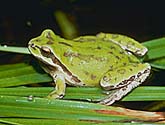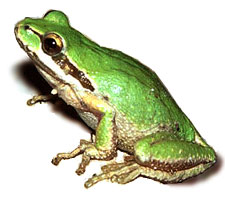
Home | About Us | Projects | Maps | Facts

Home | About Us | Projects | Maps | Facts

Pacific Treefrog Pseudacris regilla (formerly Hyla regilla) Description: Pacific Treefrogs, are small amphibians with a conspicuous dark "mask" or eyestripe extending from the nostrils through the eye as far as the shoulder. Another distinguishing feature is the rounded toepad at the end of each digit. They have a variable dorsal coloration including shades of green, tan, reddish, grey, brown or black. Individuals can even change colors! 
The ventral surface is whitish or cream with yellow on undersides of legs and lower abdomen. Their legs are long and slender; their toes have round pads, which help the frog grip and climb, and there is very little webbing between the toes, making them look quite long. They have smooth skin. They are small frogs, up to 5 centimeters long. Females are slightly larger than males, a feature common to many frogs. Range/ Habitat: The Pacific Treefrog ranges from British Columbia, Canada to the tip of Baja California, México and eastward to Montana and Nevada. The Pacific Treefrog is one of the most common and widespread frogs in California. It can be found in almost any habitat where there are suitable breeding waters which are usually small ponds. Lakes and rivers were selected because more suitable smaller water bodies or backwaters often occur at their edges. Click the map for information about the distribution of the Pacific Treefrog in California. Diet: The Pacific Treefrog eats a wide variety of arthopods. Predators of pacific treefrogs around ponds include predaceous diving beetles, giant water bugs, bluegill sunfish, and garter snakes. 
Reproduction: The Pacific Treefrog breeds from November to July in a wide array of habitats including marshes, ponds, lakes, ditches, and slow-moving streams. "One of the most fascinating characteristics of this little frog is its ability to change color. Unlike chameleons, which change their color to match their surroundings, the Pacific treefrog changes color based on the air temperature and humidity. The frogs don't control this change; it just happens naturally within a few minutes. The color change is for exactly the reason you think -- a defense mechanism to reduce the likelihood that the treefrog will become a meal for a bullfrog, raccoon, heron, snake, or other predator." Chance Finegan - National Parks Traveler The distinctive call of this frog is known around the world - the "ribbit" that Hollywood uses in all of its films as the "standard" frog call is actually the call of the Pacific Treefrog! These frogs are also called the "Chorus Frog" due to
their vocal repertoire, including distinct mating choruses. Despite the name treefrog, this species is predominantly terrestrial (lives on the ground).
Did you know?
More Information: Pacific Treefrog Natural History - with photos, audio and video clips Creature Feature: The Pacific Treefrog - National Parks Traveler Pacific Treefrog - Identification Guide Animal silhouettes available to purchase » Photo Credit: WDFW; Chris Brown |